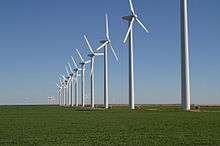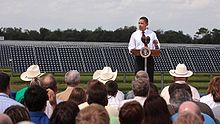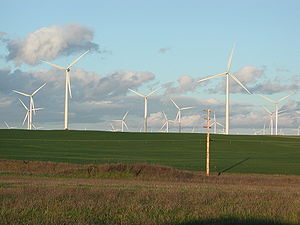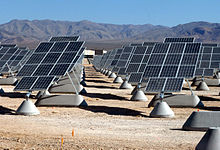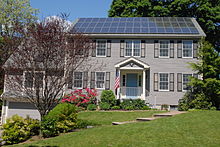- Renewable energy in the United States
-
Renewable energy Biofuel
Biomass
Geothermal
Hydroelectricity
Solar energy
Tidal power
Wave power
Wind powerRenewable energy accounted for 14.3 percent of the domestically produced electricity in the United States in the first six months of 2011.[1] Hydroelectricity is the largest producer of renewable power in the United States. In 2009, the U.S. was the world's largest producer of electricity from geothermal, solar and wind power and it trailed only China in the total production of renewable energy.
U.S. wind power installed capacity now exceeds 43,460 MW and supplies 3% of the nation's electricity.[2][3] Texas is firmly established as the leader in wind power development, followed by Iowa and California.[4] Since the U.S. pioneered the technology with Solar One, several solar thermal power stations have also been built. The largest of these solar thermal power stations is the SEGS group of plants in the Mojave Desert with a total generating capacity of 354 MW, making the system the largest solar plant of any kind in the world.[5] The largest photovoltaic power plant in North America is the 48 MW Copper Mountain Solar Facility in Boulder City, Nevada.[6] The Geysers in Northern California is the largest complex of geothermal energy production in the world.
In terms of renewable fuels for transportation, most cars on the road today in the U.S. can run on blends of up to 10% ethanol fuel, and motor vehicle manufacturers already produce vehicles designed to run on much higher ethanol blends. Corn ethanol plants are common in the country's midsection where corn is a leading crop.
The development of renewable energy and energy efficiency marks "a new era of energy exploration" in the United States, according to President Barack Obama.[7] In a joint address to the Congress on February 24, 2009, President Obama called for doubling renewable energy within the next three years.[8]
Contents
Rationale for renewables
Renewable energy technologies encompass a broad, diverse array of technologies, including solar photovoltaics, solar thermal power plants and heating/cooling systems, wind farms, hydroelectricity, geothermal power plants, and ocean power systems and the use of biomass.
The report Outlook On Renewable Energy In America explains that America needs renewable energy, for many reasons:
America needs energy that is secure, reliable, improves public health, protects the environment, addresses climate change, creates jobs, and provides technological leadership. America needs renewable energy. If renewable energy is to be developed to its full potential, America will need coordinated, sustained federal and state policies that expand renewable energy markets; promote and deploy new technology; and provide appropriate opportunities to encourage renewable energy use in all critical energy market sectors: wholesale and distributed electricity generation, thermal energy applications, and transportation.[9]
In 2009, President Barack Obama in the inaugural address called for the expanded use of renewable energy to meet the twin challenges of energy security and climate change. Those were the first references ever to the nation's energy use, to renewable resources, and to climate change in an inauguration speech of a U.S. president. President Obama looked to the near future, saying that as a nation, the United States will "harness the sun and the winds and the soil to fuel our cars and run our factories."[10]
The president's New Energy For America plan calls for a federal investment of $150 billion over the next decade to catalyze private efforts to build a clean energy future. Specifically, the plan calls for renewable energy to supply 10% of the nation's electricity by 2012, rising to 25% by 2025.[10]
In his joint address to Congress in 2009, Obama stated that:
We know the country that harnesses the power of clean, renewable energy will lead the 21st. century....Thanks to our recovery plan, we will double this nation’s supply of renewable energy in the next three years... It is time for America to lead again.[8]
Current trends
Renewable energy accounted for 10.4 percent of the domestically produced electricity in the United States in the first ten months of 2009.[11] California is a leading state and 31 percent of California's electricity comes from renewable sources. Most of this renewable electricity comes from hydropower, but 12 percent comes from "new" renewables which include wind and geothermal energy.[12] [ref has moved]
The United States has some of the best renewable energy resources in the world, which have the potential to meet a rising and significant share of the nation's energy demand. A quarter of the U.S. land area has winds strong enough to generate electricity at the same price as natural gas and coal.[12]
Many of the new technologies that harness renewables — including wind, solar, geothermal, and biofuels — are, or soon will be, economically competitive with the fossil fuels that meet 85 percent of U.S. energy needs. Dynamic growth rates are driving down costs and spurring rapid advances in technologies.[12] Energy technologies also receive government subsidies. In 2007, federal government subsidies for electricity production from renewables, coal, and nuclear were $1,008 million, $854 million and $1,267 million respectively.[13]
All but four U.S. states now have incentives in place to promote renewable energy, while more than a dozen have enacted new renewable energy laws in recent years.[12]
In California, 18% of retail electricity sales came from renewable power in 2010, up from 15% in 2009.[14]
Renewable energy suffered a setback in the United States in September 2011 with the “bankruptcy of Solyndra, a once-promising solar energy venture in California that received $535 million in federal loans. Republicans in Congress seized on the collapse of the company to question the Obama administration’s approach to supporting alternative energy ventures and the concept of so-called green jobs”.[15]
Hydroelectricity
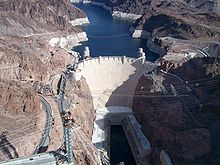 The Hoover Dam when completed in 1936 was both the world's largest electric-power generating station and the world's largest concrete structure.
The Hoover Dam when completed in 1936 was both the world's largest electric-power generating station and the world's largest concrete structure. Main article: Hydroelectric power in the United States
Main article: Hydroelectric power in the United StatesHydroelectric power is currently the largest producer of renewable power in the U.S. It produced around 6.0% of the nation's total electricity in 2008 which was 66.8% of the total renewable power in the U.S. The United States is the fourth largest producer of hydroelectricity in the world after China, Canada and Brazil. The Grand Coulee Dam is the 5th largest hydroelectric power station in the world and another six U.S. hydro plants are among the 50 largest in the world. The amount of hydroelectric power generated is strongly affected by changes in precipitation and surface runoff.[16]
Hydroelectric plants exist in at least 34 US states. Hydroelectricity projects such as Hoover Dam, Grand Coulee Dam, and the Tennessee Valley Authority have become iconic large construction projects.
Wind power
Wind power is a growing industry in the United States. Latest American Wind Energy Association figures show that U.S. wind power installed capacity now exceeds 43,460 MW and supplies 3% of the nation's electricity.[17] Texas is firmly established as the leader in wind power development, followed by Iowa and California. The U.S. became the world leader in installed wind power at the end of 2008[18] and DOE has said wind power could generate 20% of US electricity by 2030.[19][20][21]
Wind power is growing rapidly worldwide and U.S. capacity has more than doubled in the past three years. Doubling U.S. wind energy capacity over the next three years would imply no change in annual growth.[22]
These are some of the largest wind farms in the United States, as of 2011:
Wind farm Installed
capacity
(MW)State Capricorn Ridge Wind Farm 662 Texas Fowler Ridge Wind Farm 600 Indiana Horse Hollow Wind Energy Center 736 Texas Roscoe Wind Farm 781 Texas San Gorgonio Pass Wind Farm 619 California Sweetwater Wind Farm 585 Texas Tehachapi Pass Wind Farm 690 California Wind-generated electricity cost 38¢ per kilowatt-hour when the wind industry began in California in the early 1980s. Since then it has dropped to 4¢ or below at the best wind sites and some U.S. long-term supply contracts have been signed for 3¢ per kilowatt-hour. By 2010, wind farms at prime sites may be generating electricity at 2¢ per kilowatt-hour, making it one of the world’s most economical sources of electricity.[23]
There is considerable competition for wind farms among farmers in places like Iowa or ranchers in Colorado. Farmers, with no investment on their part, typically receive $3,000–5,000 per year in royalties from the local utility for siting a single, large, advanced-design wind turbine, which occupies 0.25 acres (1,000 m2) of land. This land would produce 40 bushels of corn worth $120 or, in ranch country, beef worth perhaps $15.[24]
Landscape and ecological issues may be significant for some wind farm proposals.[25] However, when appropriate planning procedures for site selection are followed, environmental problems should be minimal. Some people may still object to wind farms, but their concerns should be weighed against the need to address the threats posed by climate change and the opinions of the broader community.[26][27] Worldwide experience has shown that community consultation and direct involvement of the general public in wind farm projects has helped to increase community approval.[28]
Solar thermal power
Solar Energy Generating Systems
Solar Energy Generating Systems (SEGS) is the name given to nine solar power plants in the Mojave Desert. SEGS I-VII are located at Kramer Junction, and SEGS VIII and IX are at Harper Lake and Barstow respectively. The SEGS power plants were commissioned between 1984 and 1991.[5]
The installation uses parabolic trough solar thermal technology along with natural gas to generate electricity. The facility has a total of 400,000 mirrors and covers 1,000 acres (4 km²). The plants have a total generating capacity of 354 MW, making the system the largest solar plant of any kind in the world.[5]
Nevada Solar One
Nevada Solar One generates 64MW of power and in Boulder City, Nevada, and was built by the U.S. Department of Energy (DOE), National Renewable Energy Laboratory (NREL), and Solargenix Energy. Nevada Solar One started producing electricity in June 2007.
Nevada Solar One uses parabolic troughs as thermal solar concentrators, heating tubes of liquid which act as solar receivers. These solar receivers are specially coated tubes made of glass and steel. About 19,300 of these 4 metre long tubes are used in the newly built power plant. Nevada Solar One also uses a technology that collects extra heat by putting it into phase-changing molten salts. This energy can then be drawn on at night.[29]
Solar thermal power plants designed for solar-only generation are well matched to summer noon peak loads in prosperous areas with significant cooling demands, such as the south-western United States. Using thermal energy storage systems, solar thermal operating periods can even be extended to meet base-load needs.[30]
Under construction
The Ivanpah Solar Power Facility is a 392 megawatt (MW) solar power facility which is under construction in south-eastern California.[31] The Solana Generating Station is a 280 MW solar power plant which is under construction near Gila Bend, Arizona, about 70 miles (110 km) southwest of Phoenix. The Crescent Dunes Solar Energy Project is a 110 megawatt (MW) solar thermal power project currently under construction near Tonopah, about 190 miles (310 km) northwest of Las Vegas.[32]
Land use issues
Solar thermal power plants are large, but when looking at electricity output versus total size, they use less land than hydroelectric dams (including the size of the lake behind the dam) or coal plants (including the amount of land required for mining and excavation of the coal).[33] Some of the land in the eastern portion of the Mojave Desert is to be preserved, but the solar industry is more interested in areas of the western desert, "where the sun burns hotter and there is easier access to transmission lines".[34]
Solar photovoltaic power
The Copper Mountain Solar Facility is a 48 megawatt (MW) solar photovoltaic (PV) power plant in Boulder City, Nevada.[6] Sempra Generation began construction of the plant in January 2010 and on December 1, 2010, the company announced that it had finished the project and the facility was generating electricity.[6]
The 25 MW DeSoto Next Generation Solar Energy Center in Florida consists of over 90,000 solar panels.[35]
The Nellis Solar Power Plant was completed in December, 2007. It is located at Nellis Air Force Base in Clark County, Nevada. It includes approximately 70,000 solar panels and the peak power generation capacity of the plant is approximately 15 megawatts.[36][37]
There are also many large plants under construction. The Desert Sunlight Project is a 550 MW solar power plant under construction in Riverside County, California, that will use thin-film solar photovoltaic modules made by First Solar.[38] The Blythe Solar Power Project is a 500 MW photovoltaic station under construction in Riverside County, California. The Agua Caliente Solar Project is a 290 megawatt photovoltaic solar generating facility being built in Yuma County, Arizona. The California Valley Solar Ranch (CVSR) is a 250 megawatt (MW) solar photovoltaic power plant, which is being built by SunPower in the Carrizo Plain, northeast of California Valley.[39]
Many schools and businesses have building-integrated photovoltaic solar panels on their roof. Most of these are grid connected and use net metering laws to allow use of electricity in the evening that was generated during the daytime. New Jersey leads the nation with the least restrictive net metering law, while California leads in total number of homes which have solar panels installed. Many were installed because of the million solar roof initiative.[40] California has decided that it is not moving forward fast enough on photovoltaic generation and is considering enacting Feed-in Tariffs.[41] Washington state has a feed-in tariff of 15 ¢/kWh which increases to 54 ¢/kWh if components are manufactured in the state.[42] Hawaii and Michigan are also considering feed in tariffs.
Geothermal power
The USA is the world leader in online capacity and the generation of electricity from geothermal energy.[43] According to 2005 state energy data, geothermal energy provided approximately 16 billion kilowatt hours (kWh) of electricity—0.37% of the electricity consumed in the U.S. As of May 2007, geothermal electric power was generated in five U.S. states: Alaska, California, Hawaii, Nevada, and Utah. According to the Geothermal Energy Association's recent report, there were 75 new geothermal power projects underway in 12 states as of May 2007 . This is an increase of 14 projects in an additional three states compared to a survey completed in November 2006.[43]
The most significant catalyst behind new industry activity is the Energy Policy Act of 2005. This Act made new geothermal plants eligible for the full federal production tax credit, previously available only to wind power projects. It also authorized and directed increased funding for research by the Department of Energy, and gave the Bureau of Land Management new legal guidance and secure funding to address its backlog of geothermal leases and permits.[43]
Solar water heating
More than 1.5 million homes and businesses currently use solar water heating in the United States, representing a capacity of over 1,000 megawatts (MW) of thermal energy generation. Another 400 MW is likely to be installed over the next 3–5 years, according to the US Department of Energy. Assuming that 40 percent of existing homes in the United States have adequate access to sunlight, 29 million solar water heaters could be installed.[44]
Solar water heaters can operate in any climate. Performance varies depending on how much solar energy is available at the site, as well as how cold the water coming into the system is. The colder the water, the more efficiently the system operates.[44]
Solar water heaters reduce the need for conventional water heating by about two-thirds and pay for their installation within 4 to 8 years with electricity or natural gas savings. Compared to those with electric water heaters, Florida homeowners with solar water heaters save 50 to 85 percent on their water heating bills, according to the Florida Solar Energy Center.[44]
Biomass
Biomass is biological material derived from living, or recently living organisms, such as plants and trees and utilizes wastes or plant matter specifically grown to generate electricity or produce heat. The main advantage of using grown fuels, as opposed to fossil fuels such as coal, natural gas and oil, is that while they are growing they absorb the near-equivalent in carbon dioxide (an important greenhouse gas) to that which is later released in their burning. Although there is some debate over the net carbon neutrality and near term affects of using the biomass for energy a key difference is the relatively short carbon recycle period of grown biomass (several years or decades) as opposed to the millions of years it took to turn carbon into fossil fuels. With proper conservation and growing techniques biomass can be an important renewable energy source.
Biomass can be utilized for all three major energy needs: electricity, heating/cooling and transportation fuels. However, each usage is distinctly different from the others, especially regarding efficiency - the percentage of energy utilized from the biomass source. Whereas pellets for heating can be up to 90% efficient, bio-electricity plants are comparable to coal power plants, with around 30% efficiency, and biofuels from crops or algae even less.
Biofuels
Most cars on the road today in the U.S. can run on blends of up to 10% ethanol, and motor vehicle manufacturers already produce vehicles designed to run on much higher ethanol blends. Ford, DaimlerChrysler, and GM are among the automobile companies that sell “flexible-fuel” cars, trucks, and minivans that can use gasoline and ethanol blends ranging from pure gasoline up to 85% ethanol (E85). By mid-2006, there were approximately six million E85-compatible vehicles on U.S. roads.[45]
The challenge is to expand the market for biofuels beyond the farm states where they have been most popular to date.[46] Flex-fuel vehicles are assisting in this transition because they allow drivers to choose different fuels based on price and availability. The Energy Independence and Security Act of 2007, which calls for 15.2 billion US gallons (58,000,000 m3) of biofuels to be used annually by 2012, will also help to expand the market.[45]
The expanding ethanol and biodiesel industries are providing jobs in plant construction, operations, and maintenance, mostly in rural communities. According to the Renewable Fuels Association, the ethanol industry created almost 154,000 U.S. jobs in 2005 alone, boosting household income by $5.7 billion. It also contributed about $3.5 billion in tax revenues at the local, state, and federal levels.[45] On the other hand, in 2007, the biofuel industry received $3.25 billion in federal government support.[47]
Policy and promotion
Solar America Initiative
The Solar America Initiative (SAI)[48] is a part of the Federal Advanced Energy Initiative to accelerate the development of advanced photovoltaic materials with the goal of making it cost-competitive with other forms of renewable electricity by 2015.
The U.S. Department of Energy Solar Energy Technology Program (SETP) will achieve the goals of the SAI through partnerships and strategic alliances by focusing primarily on four areas:
- Market Transformation — activities that address marketplace barriers and offer the opportunity for market expansion
- Device and Process Proof of Concept — R&D activities addressing novel devices or processes with potentially significant performance or cost advantages
- Component Prototype and Pilot-Scale Production — R&D activities emphasizing development of prototype PV components or systems produced at pilot-scale with demonstrated cost, reliability, or performance advantages
- System Development and Manufacturing — collaborative R&D activities among industry and university partners to develop and improve solar energy technologies
California Solar Initiative
As part of Governor Arnold Schwarzenegger's Million Solar Roofs Program, California has set a goal to create 3,000 megawatts of new, solar-produced electricity by 2017 - moving the state toward a cleaner energy future and helping lower the cost of solar systems for consumers. This is a comprehensive $2.8 billion program.[49]
The California Solar Initiative offers cash incentives on solar PV systems of up to $2.50 a watt. These incentives, combined with federal tax incentives, can cover up to 50% of the total cost of a solar panel system.[49] It should also be noted that there are many financial incentives to support the use of renewable energy in other US states.[50]
EPA initiatives
To promote energy efficiency and environmentally sensitive energy generation, Environmental Protection Agency facilities in the United States are using renewable energy technologies to supplement or replace a large portion of their energy requirements at the following facilities:
- Ada, Oklahoma (geothermal heat pump)
- Ann Arbor, Michigan (fuel cell)
- Chicago, Illinois, Regional Office (photovoltaic array)
- Corvallis, Oregon (photovoltaic array)
- Edison, New Jersey (solar water heating)
- Gulf Breeze, Florida (solar lighting)
- Golden, Colorado (wind power and transpired solar collector)
- Manchester, Washington (wind power)
- Research Triangle Park, North Carolina (photovoltaic solar panels and street lights).[51]
Green Power Partnership
Main article: Green Power PartnershipThe U.S. Environmental Protection Agency (EPA) has named the top 20 partners in its Green Power Partnership that are generating their own renewable energy on-site. Combined, the top 20 partners are generating more than 736 million kilowatt-hours of renewable energy on-site each year, enough to power more than 61,000 average U.S. homes.[52]
Renewable portfolio standards
A Renewable Portfolio Standard refers to legislation that creates a market in tradeable renewable or green electricity certificates. Electricity distributors or wholesaler purchasers of electricity are required to source a specified percentage of their electricity (portfolio) from renewable generation sources. Liable entities that fall short of their quota can purchase certificates from accredited suppliers who have generated renewable electricity and obtained and registered certificates to sell on that market.
Renewable energy organizations
The American Council on Renewable Energy (ACORE), is a non-profit organization with headquarters in Washington DC. It was founded in 2001 as a unifying forum for bringing renewable energy into the mainstream of American’s economy and lifestyle. In 2010 ACORE had over 700 member organizations.[53] In 2007, ACORE published Outlook On Renewable Energy In America, a two volume report about the future of renewable energy in the United States.[54] It has been said that this report exposes a "new reality for renewable energy in America."[55]
The Environmental and Energy Study Institute (EESI) is a non-profit organization which promotes environmentally sustainable societies. Founded in 1984 by a group of Congressional Members, EESI seeks to be a catalyst that moves society away from environmentally damaging fossil fuels and toward a clean energy future. EESI presents policy solutions that will result in decreased global warming and air pollution; improvements in public health, energy security and rural economic development opportunities; increased use of renewable energy sources and improved energy efficiency.
An important part of the mission of the National Renewable Energy Laboratory (NREL) is the transfer of NREL-developed technologies to renewable energy markets. NREL's Technology Transfer Office supports laboratory scientists and engineers in the successful and practical application of their expertise and the technologies they develop. R&D staff and facilities are recognized and valued by industry, as demonstrated through many collaborative research projects and licensed technologies with public and private partners. NREL's innovative technologies have also been recognized with 39 R&D 100 Awards.
The Rocky Mountain Institute (RMI) is an organization dedicated to research, publication, consulting, and lecturing in the general field of sustainability, with a special focus on profitable innovations for energy and resource efficiency. RMI is headquartered in Snowmass, Colorado, and also maintains offices in Boulder, Colorado. RMI has recently published the book Winning the Oil Endgame.
See also
- American Council on Renewable Energy
- Americas Energy and Climate Symposium
- Energy conservation in the United States
- Efficient energy use
- Energy policy of the United States
- Solar power in the United States
- List of solar thermal power stations
- List of wind farms in the United States
- List of U.S. states by electricity production from renewable sources
- List of renewable energy topics by country
- Presidential Climate Action Project
- Renewable energy commercialization
References
- ^ US Energy Information Administration, Electric Power Monthly, June 2011.
- ^ "Q3 Report: Rebounding U.S. Wind Industry Stays Ahead of Sluggish 2010". Renewable Energy World. 26 October 2011. http://www.renewableenergyworld.com/rea/news/article/2011/10/q3-report-rebounding-u-s-wind-industry-stays-ahead-of-sluggish-2010?cmpid=WindNL-Thursday-November3-2011.
- ^ "US wind power capacity up in '09, but jobs stalled". Reuters. 2010-01-26. http://www.reuters.com/article/idUSN2211296320100126?type=marketsNews.
- ^ American Wind Energy Association, Annual U.S. wind power rankings track industry's rapid growth
- ^ a b c SEGS I, II, III, IV, V, VI, VII, VIII & IX
- ^ a b c America's Largest PV Power Plant Is Now Live (December 6, 2010), Renewable Energy World.
- ^ http://apps1.eere.energy.gov/news/news_detail.cfm/news_id=12475
- ^ a b Remarks of President Barack Obama -- Address to Joint Session of Congress
- ^ American Council On Renewable Energy, (2007). The Outlook on Renewable Energy in America Volume II: Joint Summary Report page 7
- ^ a b http://apps1.eere.energy.gov/news/news_detail.cfm/news_id=12194
- ^ US Energy Information Administration, Electric power monthly, January 2010.
- ^ a b c d Environmental and Energy Study Institute, Renewable energy becoming cost competitive with fossil fuels in the U.S.
- ^ "Federal Financial Interventions and Subsidies in Energy Markets in 2007". Energy Information Administration. http://www.eia.doe.gov/oiaf/servicerpt/subsidy2/pdf/execsum.pdf.
- ^ "California's Largest Utilities Hit 18% Renewables in 2010". U.S. Department of Energy. March 8, 2011. http://www1.eere.energy.gov/commercialization/news_detail.html?news_id=16774.
- ^ John Broder (October 10, 2011). "The Year of Peril and Promise in Energy Production". New York Times. http://www.nytimes.com/2011/10/11/business/energy-environment/the-year-of-peril-and-promise-in-energy-production.html?src=un&feedurl=http%3A%2F%2Fjson8.nytimes.com%2Fpages%2Fbusiness%2Fglobal%2Findex.jsonp.
- ^ US Energy Information Administration (January 2010) Electric Power Annual 2008, DOE/EIA-0348(2008), p.2-3, PDF file, downloaded 24 January 2010.
- ^ "Q3 Report: Rebounding U.S. Wind Industry Stays Ahead of Sluggish 2010". Renewable Energy World. 26 October 2011. http://www.renewableenergyworld.com/rea/news/article/2011/10/q3-report-rebounding-u-s-wind-industry-stays-ahead-of-sluggish-2010?cmpid=WindNL-Thursday-November3-2011.
- ^ U.S., China and Spain lead world wind power market in 2007
- ^ http://www1.eere.energy.gov/windandhydro/pdfs/1_overview-demeo.pdf
- ^ http://www.networkworld.com/community/node/27745
- ^ http://www.eesi.org/072508_Wind_Energy_Supply
- ^ http://planetark.org/wen/51189
- ^ "Stabilizing Climate" in Lester R. Brown, Plan B 2.0 Rescuing a Planet Under Stress and a Civilization in Trouble (NY: W.W. Norton & Co., 2006), p. 189.
- ^ "Stabilizing Climate" in Lester R. Brown, Plan B 2.0 Rescuing a Planet Under Stress and a Civilization in Trouble (NY: W.W. Norton & Co., 2006), p. 191.
- ^ Gone with the wind, New Scientist, 8 July 2006, pp. 36-39
- ^ The Australia Institute (2006).Wind Farms The facts and the fallacies Discussion Paper Number 91, October, ISSN 1322-5421
- ^ Case Study – Arga Where the wild things are
- ^ The world's leader in Wind Power
- ^ Nevada: Solar energy advances discussed
- ^ Spain pioneers grid-connected solar-tower thermal power
- ^ Steven Mufson. Solar power project in Mojave Desert gets $1.4 billion boost from stimulus funds Washington Post, February 23, 2010.
- ^ "DOE Finalizes $737 Million Loan Guarantee to Tonopah Solar Energy for Nevada Project" (Press release). Loan Programs Office (LPO), Dept. of Energy (DOE). September 28, 2011. https://lpo.energy.gov/?p=5246. Retrieved 29 September 2011.
- ^ Solel (2007).Ten facts about solar thermal power Retrieved December 18, 2008.
- ^ A Mojave power failure A shortfall in Mojave protection bill, Los Angeles Times, editorial, December 26, 2009.
- ^ FPL Commissions DeSoto Next Generation Solar Energy Center
- ^ Nellis activates Nations largest PV Array
- ^ Largest U.S. Solar Photovoltaic System Begins Construction at Nellis Air Force Base
- ^ "DOE Closes on Four Major Solar Projects". Renewable Energy World. 30 September 2011. http://www.renewableenergyworld.com/rea/news/article/2011/09/doe-closes-on-three-major-solar-projects?cmpid=SolarNL-Tuesday-October4-2011.
- ^ "NRG Energy Completes Acquisition of 250-Megawatt California Valley Solar Ranch from SunPower". MarketWatch. 30 September 2011. http://www.marketwatch.com/story/nrg-energy-completes-acquisition-of-250-megawatt-california-valley-solar-ranch-from-sunpower-2011-09-30.
- ^ Million Solar Roofs Initiative
- ^ Are Feed-in Tariffs a Possibility in California?
- ^ Washington State Passes Progressive Renewable Energy Legislation
- ^ a b c Geothermal Energy Association, 6 Million American Households to be Powered by Geothermal Energy, New Survey Reports
- ^ a b c Environmental and Energy Study Institute, Solar water heating
- ^ a b c Worldwatch Institute and Center for American Progress (2006). American energy: The renewable path to energy security
- ^ "The craze for maize", The Economist, May 12, 2007, pp.33-34
- ^ "Federal Financial Interventions and Subsidies in Energy Markets in 2007". Energy Information Administration. http://www.eia.doe.gov/oiaf/servicerpt/subsidy2/pdf/execsum.pdf.
- ^ EERE: Solar Energy Technologies Program Home Page
- ^ a b California Public Utilities Commission, The California Solar Initiative
- ^ Database of State Incentives for Renewables and Efficiency, Financial Incentives in the USA
- ^ U.S. Environmental Protection Agency, Onsite Renewable Technologies
- ^ http://www.lacsd.org/
- ^ American Council on Renewable Energy, Member Benefits
- ^ American Council On Renewable Energy, (2007). The Outlook On Renewable Energy In America
- ^ 635 GW Possible with U.S. Political Shift Renewable Energy Access, 2 May 2007.
Wind power in the United States Wind power by state 
Large wind farms Alta Wind Energy Center · Altamont Pass · Biglow Canyon · Buffalo Gap · Capricorn Ridge · Fowler Ridge · Horse Hollow · Lone Star · Panther Creek · Peetz · Peñascal · Roscoe · San Gorgonio Pass · Klondike · Shepherds Flat · Sweetwater · Tehachapi Pass · Twin Groves · Windy Point/Windy FlatsWind power companies Clipper Windpower · Deepwater Wind · General Electric · National Wind · Native Wind · NextEra Energy Resources · Siemens Power Generation · Southwest Windpower · Urban Green Energy · Vestas · Wind Capital GroupSolar power in the United States Solar power by state Arizona · California · Hawaii · Nevada · New Jersey · New Mexico · OregonSolar power plants Alamosa · Blue Wing · Blythe Photovoltaic Power Plant · Copper Mountain · Davidson County · DeSoto · El Dorado · Holaniku · Kimberlina · Martin · Nellis · Nevada Solar One · Sierra SunTower · Solar Energy Generating Systems · Space Coast · WyandotPlanned or
under constructionAgua Caliente · Antelope Valley · Blythe Solar Power Project · Calico · California Valley · Desert Sunlight Project · Imperial Valley · Ivanpah · Mesquite · Mojave Solar Park · Panoche Valley · Rancho Cielo · Rice · Solana · TopazCompanies Ascent Solar · Ausra · BP Solar · BrightSource · eSolar · EnviroMission · First Solar · Practical Solar · Pyron Solar · Sharp Solar · SkyFuel · Skyline Solar · Sopogy · Stirling Energy Systems · YingliResidential
solar power1BOG · Citizenre · Community solar farm · PACE Financing · REC Solar · Sungevity · SolarCity · Sundog Solar · Sunetric · SunRunRenewable energy by country Wind by regionby countrySolar by regionAustralia · Canada · China · Germany · Greece · India · Israel · Italy · Japan · Morocco · Pakistan · Portugal · Romania · Spain · Turkey · United Kingdom · United StatesGeothermal by countryAustralia · Canada · Chile · China · Denmark · Germany · Iceland · Indonesia · Japan · Kenya · Mexico · New Zealand · Philippines · Portugal · Romania · Russia · Turkey · United Kingdom · United States · West Indies
Wikimedia Foundation. 2010.

